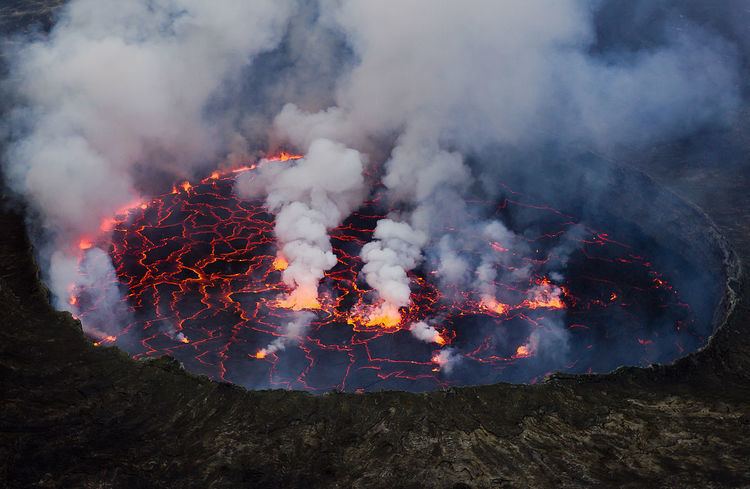 | ||
Lava lakes are large volumes of molten lava, usually basaltic, contained in a volcanic vent, crater, or broad depression. The term is used to describe both lava lakes that are wholly or partly molten and those that are solidified (sometimes referred to as frozen lava lakes in this case).
Contents
Formation
Lava lakes can form in three ways:
Behaviors
Lava lakes occur in a variety of volcanic systems, ranging from the basaltic Erta Ale lake in Ethiopia and the basaltic andesite volcano of Villarrica, Chile, to the unique phonolitic lava lake at Mt. Erebus, Antarctica. Lava lakes have been observed to exhibit a range of behaviours. A “constantly circulating, apparently steady-state” lava lake was observed during the 1969–1971 Mauna Ulu eruption of Kilauea, Hawaii. By contrast, a lava lake at the 1983–1984 Pu'u 'O'o eruption of Kilauea displayed cyclic behaviour with a period of 5–20 minutes; gas “pierced the surface” of the lake, and the lava rapidly drained back down the conduit before the onset of a new phase of lake activity. The behaviour observed is influenced by the combined effects of pressure within the reservoir, exsolution and decompression of gas bubbles within the conduit and, potentially, exsolution of bubbles within the magma reservoir. Superimposed upon this is the effect of bubbles rising through the liquid, and coalescence of bubbles within the conduit. The interactions of these effects can create either a steady-state recirculating lake, or a lake level that periodically rises and then falls.
Notable examples
Persistent lava lakes are a rare phenomenon. Only a few volcanoes have hosted persistent or near-persistent lava lakes during recent decades:
Kīlauea uniquely has two persistent lava lakes: one in the Halemaʻumaʻu vent cavity within the summit caldera, and another within the Puʻu ʻŌʻō cone located on the east rift zone of the volcano.
Nyiragongo lava lake has usually been the largest and most voluminous in recent history, reaching 700 meters wide in 1982, although Masaya is believed to have hosted an even larger lava lake at the time of the Spanish conquest, being 1000 meters wide in 1670. The lava lake at Masaya came back in January 2016.
In addition to the aforementioned persistent lava lakes, a certain number of occurrences of temporary lava lakes (sometimes called lava ponds or lava pools, depending on their size and nature) have also been observed and are listed in the following table.
